Exploring CD3, CD4, and CD8 T Cells in Immunology
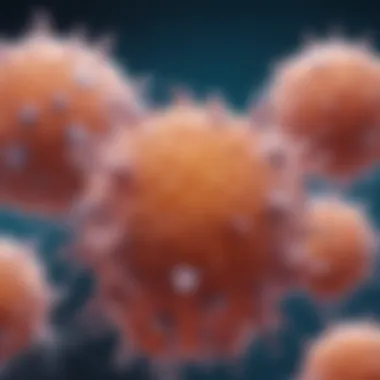
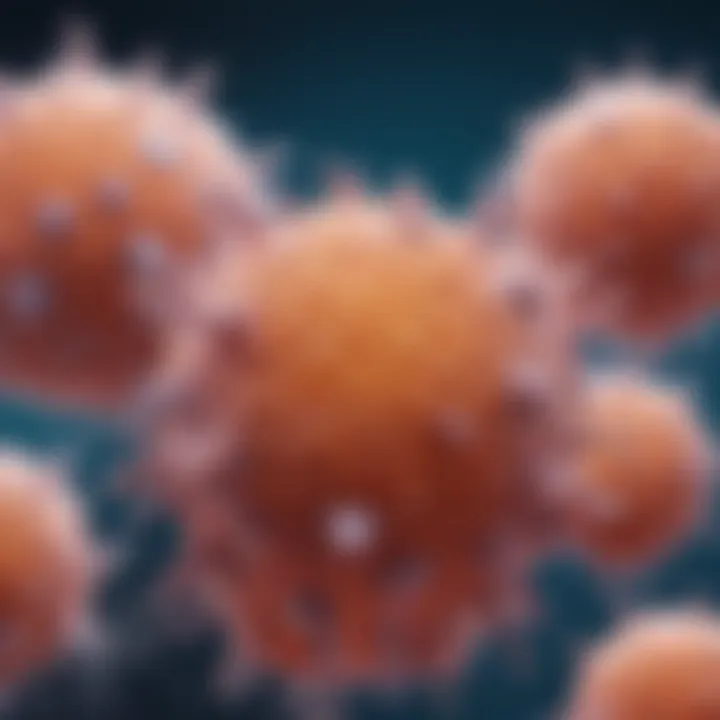
Article Overview
The immune system is a highly complex network, essential for safeguarding the human body against infections and diseases. Within this intricate framework, CD3, CD4, and CD8 T cells are critical players. They not only interact with other immune components but also have distinct functionalities that contribute to overall immune health.
Purpose of the Article
The aim of this article is to provide a detailed examination of the roles and mechanisms of CD3, CD4, and CD8 T cells. Understanding how these T cells operate can reveal insights into their implications in both health and disease. Such knowledge is vital for those involved in immunotherapy and research related to immune responses.
Relevance to Multiple Disciplines
This topic is significant across various disciplines, including immunology, biology, medicine, and biotechnology. Practitioners and researchers in these fields can gain insights into the cellular interactions that shape immune responses, which can influence therapeutic approaches in conditions such as autoimmune diseases and cancers.
Research Background
A thorough understanding of CD3, CD4, and CD8 T cells necessitates a historical as well as a conceptual view of their discovery and functions.
Historical Context
The discovery of T cells dates back to the mid-20th century. Researchers observed that the thymus influenced lymphocyte differentiation. CD4 and CD8 T cells emerged as distinct subsets, identified by their surface markers in the 1980s. This historic context has paved the path for ongoing studies aimed at delineating their complex roles in the immune response.
Key Concepts and Definitions
To appreciate the intricacies of CD3, CD4, and CD8 T cells, it is imperative to understand several key definitions:
- CD3: A complex of proteins that is essential for T cell activation.
- CD4 T cells: Also known as helper T cells, they assist other immune cells in responding to infections.
- CD8 T cells: These are cytotoxic T cells that target and kill infected or cancerous cells.
Engaging with these concepts will help illuminate the unique yet interdependent roles of these T cell populations in immune functionality.
Prolusion to T Cells and Their Classification
Understanding T cells is essential for grasping how the immune system functions. These cells are not only involved in recognizing antigens but are also crucial for coordinating the body's immune response. This section sets the groundwork for a more detailed exploration of CD3, CD4, and CD8 T cells, providing insight into their classification and roles in immunology.
Overview of T Cells
T cells, or T lymphocytes, are a type of white blood cell that plays a central role in the adaptive immune system. They originate from hematopoietic stem cells in the bone marrow and migrate to the thymus for maturation. T cells are characterized by their specific receptors, which allow them to identify and respond to antigens, making them pivotal in immune surveillance and response.
The main types of T cells include Helper T cells, Cytotoxic T cells, and Regulatory T cells. Each type has distinct functionalities, contributing uniquely to the immune landscape. Understanding these categories offers invaluable insight into their specific functions and interactions in the immune response.
Categories of T Cells
Helper T Cells
Helper T cells, often recognized by their CD4 surface protein, are quintessential in orchestrating immune responses. They primarily aid in enhancing the activity of B cells and other T cells. A notable aspect of Helper T cells is their ability to produce cytokines, which are signaling molecules that aid in mediating immune responses. This characteristic makes them a strong focus in immunological studies.
The unique feature of Helper T cells is their capability to differentiate into subtypes, each with specialized functions such as T cells for fighting intracellular pathogens and T cells, which assist in responses against extracellular parasites. Their regulatory role significantly impacts the overall effectiveness of the immune response.
Cytotoxic T Cells
Cytotoxic T cells, marked by the presence of CD8 proteins, are essential for their aggressive role in eliminating infected or cancerous cells. This specificity is crucial for tumor surveillance and control of virally infected cells. They operate by recognizing antigens presented by MHC Class I molecules on infected cells, leading to their destruction.
A key characteristic is their lethal mechanisms, employing perforin and granzymes to induce apoptosis in target cells. While highly effective, the reliance on specific antigen recognition can limit their effectiveness in rapidly mutating pathogens or in cancer, where antigen expression can be lost.
Regulatory T Cells
Regulatory T cells, distinguished by the CD25 marker, have a fundamental role in maintaining immune homeostasis and preventing autoimmunity. They work by inhibiting the activation and proliferation of other T cells, thereby ensuring that immune responses do not become overly aggressive.
The most unique aspect of Regulatory T cells is their ability to produce immunosuppressive cytokines, which modulate immune activity. This function is critically beneficial in preventing self-reactive immune responses. However, excessive regulatory activity can sometimes hinder effective immune responses against infections or tumors, leading to a delicate balance in their function.
In summary, T cells, classified into Helper, Cytotoxic, and Regulatory types, each serve distinct yet interconnected roles in the immune system. Their intricate functions underscore their significance in both health and disease.
In summary, T cells, classified into Helper, Cytotoxic, and Regulatory types, each serve distinct yet interconnected roles in the immune system. Their intricate functions underscore their significance in both health and disease.
Significance of Markers
The CD markers, or Cluster of Differentiation markers, have a central role in immunology, particularly in the characterization and functionality of T cells. Their significance extends beyond mere identification of cell types. CD markers provide insights into the immune system's complexity and its intricate responses to pathogens and disease.
Understanding CD markers is crucial for researchers and clinicians alike. They enable precise classification of immune cells, allowing for tailored therapeutic interventions. For example, the presence of specific CD markers can help determine whether a T cell is a helper, cytotoxic, or regulatory type. This classification is vital for devising strategies in immunotherapy, particularly when combating cancer or autoimmunity.
Furthermore, the interpretation of CD markers allows for heightened understanding of immune responses during vaccination and infection. It also aids in monitoring immune status in various diseases. As we explore the roles of CD3, CD4, and CD8, understanding these markers can illuminate the pathways of cell communication and activation in the immune system.
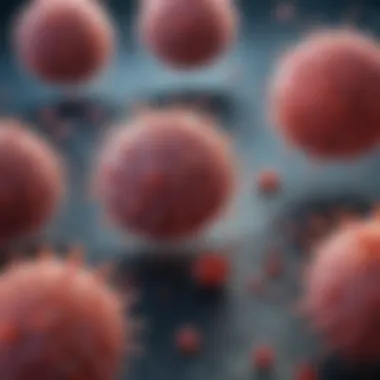

Understanding Cluster of Differentiation ()
Cluster of Differentiation refers to a system used for identifying surface molecules on immune cells. These glycoproteins serve as markers for immune cell classification. Each marker has a unique role in the immune response, influencing cell signaling, activation, and interactions with other cells. For instance, CD3 is associated with all T cells and is integral in T cell receptor signaling, thus serving as a fundamental marker in T cell biology.
The system has evolved into a standard nomenclature for identifying specific immune cell types. This categorization facilitates communication among researchers and clinicians, allowing for a shared understanding of immune mechanisms. Without this classification, the complexity of immune interactions would be much harder to grasp, hindering advancements in immunotherapy and other therapeutic areas.
Roles of CD3 in T Cell Activation
CD3 is an essential CD marker, crucial for the activation of T cells. Found on all T cells, it forms a part of the T cell receptor (TCR) complex. When an antigen binds to the TCR, CD3 transmits signals that are necessary for T cell activation. This signal cascade triggers cellular responses that lead to T cell proliferation and differentiation into effector cells.
The significance of CD3 extends to its use in clinical settings. For example:
- Therapeutic Targeting: Drugs targeting CD3, such as monoclonal antibodies, are being explored for treating various conditions, including autoimmune diseases.
- Research Applications: CD3 is used in research to study T cell development, activation, and function.
In summary, CD markers, particularly CD3, serve as essential tools for understanding T cell functionality and their roles in the immune system. Their emerging relevance in clinical research further emphasizes the need to deepen our comprehension of T cell biology and its implications for human health.
The Role of CD4 T Cells
CD4 T cells, also known as helper T cells, play a crucial role in the adaptive immune response. Their main function is to assist other immune cells in performing their tasks. This support includes activating B cells and cytotoxic T cells, promoting macrophage activity, and facilitating communication within the immune system. Understanding CD4 T cells is essential for comprehending their impact on health and disease.
Functionality of CD4 T Cells
CD4 T cells exhibit versatility in immune function. They activate various immune pathways which are vital for clearing infections and orchestrating responses to antigens.
Activation of B Cells
The activation of B cells by CD4 T cells is critical for antibody production. When CD4 T cells recognize an antigen presented by MHC class II molecules on B cells, they provide necessary signals through cytokines. This interaction not only stimulates B cell proliferation but also drives class switching, allowing B cells to produce different types of antibodies. This characteristic makes the activation of B cells a cornerstone of humoral immunity.
However, this process can also lead to disadvantages. If B cells are improperly activated, it might contribute to autoimmunity, where the body mistakenly targets its own cells.
Regulation of Cytotoxic T Cells
CD4 T cells also play a pivotal role in regulating cytotoxic T cells. They enhance the cytotoxic activity of CD8 T cells through cytokine release. These signals ensure that CD8 T cells can effectively target and kill infected or malignant cells. This regulation is beneficial for maintaining proper immune balance, preventing excessive immune responses that can lead to tissue damage.
Yet, overregulation can suppress necessary immune responses against infections, leading to persistence of pathogens in the body.
T Cell Collaboration
Collaboration among T cells is a hallmark of a robust immune response. CD4 T cells orchestrate this by helping various types of T cells communicate. They facilitate synergistic activity among T, T, and memory T cells. This collaboration results in a more precise and adaptive immune response to pathogens.
Nevertheless, effective collaboration requires stringent control. Poor collaboration can hinder immune efficiency, resulting in inadequate responses against complex infections.
Subtypes of CD4 T Cells
CD4 T cells are not a homogeneous population; they can differentiate into various subtypes, each with specialized functions in the immune system.
T Cells
T cells are crucial for producing cytokines like interferon-gamma, which enhance cell-mediated immunity. They are essential for stimulating macrophages and promoting the cytotoxic activity of CD8 T cells. The advantage of T cells lies in their ability to fight intracellular pathogens effectively. However, an overactive T response can contribute to autoimmune diseases.
T Cells
T cells play a significant role in orchestrating the response against extracellular pathogens, particularly parasites. They promote B cell activation and enhance antibody production. The presence of T cells is beneficial in allergic responses and in fighting helminths. However, excessive T responses can lead to allergies and asthma.
T7 Cells
T7 cells are involved in inflammation and defense against fungal infections. They secrete IL-17, which attracts neutrophils and other immune cells to the site of infection. This unique feature makes T7 cells important in chronic inflammatory conditions and autoimmune diseases. On the downside, an excessive T7 response can exacerbate tissue destruction.
Tfh Cells
T follicular helper (Tfh) cells are specialized CD4 T cells that assist B cells within germinal centers of lymph nodes. They promote B cell differentiation and class switching through direct cell contact and cytokine production. Tfh cells are crucial for long-term immunity. However, dysfunctional Tfh cells can compromise vaccine efficacy and lead to insufficient antibody responses.
The Function of CD8 T Cells
CD8 T cells, also known as cytotoxic T cells, are integral to the immune response. Their primary role is to directly kill infected or cancerous cells. Understanding their functionality reveals significant insights into how the immune system operates. The mechanisms employed by these cells, especially in distinguishing self from non-self, have vast implications in immunology and therapeutic strategies.
Mechanisms of Cytotoxicity
Perforin-Granzymes Pathway
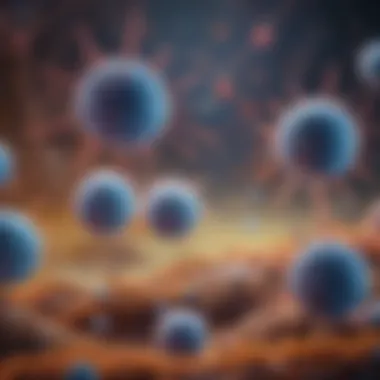

The perforin-granzymes pathway is a key method used by CD8 T cells to induce apoptosis in target cells. Upon activation, CD8 T cells release perforin, a protein that forms pores in the membrane of the infected cell. This action allows entry for granzymes, serine proteases that trigger apoptosis within the target cell. This pathway is notable for its efficiency and speed. It ensures rapid elimination of cells that present foreign antigens or harbour pathogens.
Key characteristics include:
- Direct Action: This pathway allows T cells to exert a direct cytotoxic effect without the need for extensive signaling.
- Speed: The rapid response is crucial during acute infections.
The unique feature of the perforin-granzymes pathway lies in its capacity to eliminate multiple target cells simultaneously. However, its disadvantages include potential damage to surrounding healthy tissue if not properly regulated.
Fas Ligand Pathway
The Fas ligand pathway represents another essential cytotoxic method. CD8 T cells express Fas ligand, which binds to the Fas receptor on target cells. This binding triggers a cascade of events that lead to programmed cell death. This pathway is critical for the removal of cells that are infected or dysfunctional.
A key characteristic of the Fas ligand pathway is its ability to induce apoptosis without the need for cytokine secretion. This characteristic makes it advantageous in certain contexts, particularly when rapid clearance is necessary.
The Fas ligand pathway uniquely contributes to maintaining immune homeostasis, ensuring that autoreactive cells are efficiently eliminated. However, it can also lead to immune evasion by some tumors, complicating therapeutic approaches.
Memory CD8 T Cells
Memory CD8 T cells are a specialized subset that plays a pivotal role in long-term immunity. After an initial infection, a portion of activated CD8 T cells differentiates into memory cells. These cells remain in the body, ready to respond quickly and efficiently to subsequent infections by the same pathogens.
Memory CD8 T cells are characterized by their ability to rapidly proliferate and mount a strong immune response upon re-exposure to the antigen. This rapid action can significantly reduce the severity and duration of infections.
In summary, understanding the function of CD8 T cells, including their mechanisms of cytotoxicity and the role of memory cells, enhances our grasp of the immune response. These insights are invaluable for advancing immunotherapies and developing effective vaccines.
T Cell Development and Differentiation
Understanding T cell development and differentiation is essential to grasp the dynamics of the adaptive immune response. This process begins in the bone marrow, where hematopoietic stem cells give rise to T cell progenitors. These progenitors migrate to the thymus, where they undergo a series of critical stages that shape their functions and identities. T cell differentiation is vital for the establishment of a diverse and functional T cell repertoire, which is necessary for effective immune surveillance.
The selection processes that occur in the thymus ensure that mature T cells can recognize foreign antigens while remaining tolerant to self-antigens. This balance is crucial to prevent autoimmune responses and maintain immune homeostasis. Therein lies the significance of studying T cell development; it can provide insights into various immunological disorders and potential therapeutic avenues.
Origin of T Cells in the Thymus
T cells originate in the bone marrow but migrate to the thymus to complete their development. The thymus is a specialized organ that plays a fundamental role in T cell maturation. In this environment, T cells undergo two main selection processes: positive and negative selection.
- Positive Selection: In this stage, thymocytes that can adequately recognize self-MHC molecules receive survival signals. Those that fail to bind MHC molecules undergo apoptosis. This selection ensures that only T cells capable of responding to antigens presented by MHC molecules will survive.
- Negative Selection: This process eliminates T cells that strongly recognize self-antigens presented by MHC molecules. By purging these potentially autoreactive thymocytes, the thymus helps maintain immune tolerance, thus preventing autoimmune diseases.
The intricate processes occurring in the thymus are pivotal. They not only influence the functional abilities of T cells but also impact the overall immune system's integrity. It is insightful to know that defects in T cell development can lead to immune deficiencies and diseases.
Signals for T Cell Maturation
T cell maturation requires a combination of intrinsic programming and extrinsic signals from the thymic microenvironment. Key signals and factors critical to T cell maturation include:
- Cytokines: These signaling molecules regulate T cell differentiation. For example, IL-2 promotes T cell proliferation and survival, while IL-7 is vital for early T cell development.
- Notch Signaling: This pathway is crucial for determining T cell lineage. Notch interactions help specify T cell over B cell development in the lymphoid organs.
- Co-stimulatory Signals: For T cells to proliferate and acquire functionality, they need additional signals from antigen-presenting cells (APCs). CD28 interacts with CD80/CD86 on APCs to provide necessary stimulation for T cells.
These signals work synergistically to drive T cell maturation, ensuring that a diverse yet controlled population of T cells emerges. Understanding this maturation process allows researchers to explore how alterations can lead to immune-related diseases or inform innovative therapeutic strategies.
"The thymus serves as the cradle where T cells learn to distinguish friend from foe—a process vital for a healthy immune system."
"The thymus serves as the cradle where T cells learn to distinguish friend from foe—a process vital for a healthy immune system."
In summary, T cell development and differentiation are complex but essential processes that shape the immune system's capacity to respond to infections and maintain tolerance to self. Further insights into these mechanisms may open doors to new immunotherapeutic strategies and improved treatments for immune-related conditions.
Interactions with Antigen-Presenting Cells
Interactions between T cells and antigen-presenting cells (APCs) are critical for the initiation and modulation of the immune response. This relationship is essential for establishing effective immunity and for enabling T cells to perform their functions in defense against pathogens and tumors. APCs, including dendritic cells, macrophages, and B cells, play a pivotal role in presenting antigens to T cells, which is central for T cell activation.
APCs are responsible for processing antigens and displaying antigenic peptides on their surface bound to major histocompatibility complex (MHC) molecules. This interaction with T cells occurs via the T cell receptor (TCR), which recognizes the specific antigen-MHC complex. An understanding of these processes allows researchers to explore how T cell responses can be enhanced or suppressed, which has far-reaching implications in immunotherapy and vaccination strategies.
Moreover, the role of co-stimulatory signals from APCs is important for full T cell activation. These signals, such as those provided through the interaction of CD28 on T cells with CD80/CD86 on APCs, complement TCR signaling. Without these signals, T cells can become anergic or undergo apoptosis, which can have significant implications for immune tolerance and responses to chronic infections.
Effective T cell activation requires not only TCR recognition of the antigen but also co-stimulatory signals from APCs.
Effective T cell activation requires not only TCR recognition of the antigen but also co-stimulatory signals from APCs.
In summary, understanding the interactions between T cells and APCs is fundamental for immunological research. This knowledge contributes to the development of therapeutic approaches for various diseases, including autoimmune disorders and cancers.
Role of Dendritic Cells
Dendritic cells are specialized APCs and are particularly important for T cell activation. They are considered the most potent activators of naive T cells, as they can bridge innate and adaptive immune responses. Dendritic cells capture antigens in peripheral tissues and migrate to lymph nodes, where they prime T cells. They express high levels of MHC class II molecules, allowing them to present processed antigens effectively.
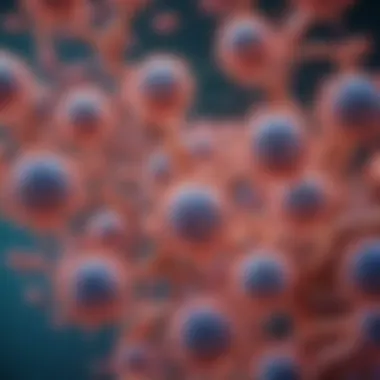
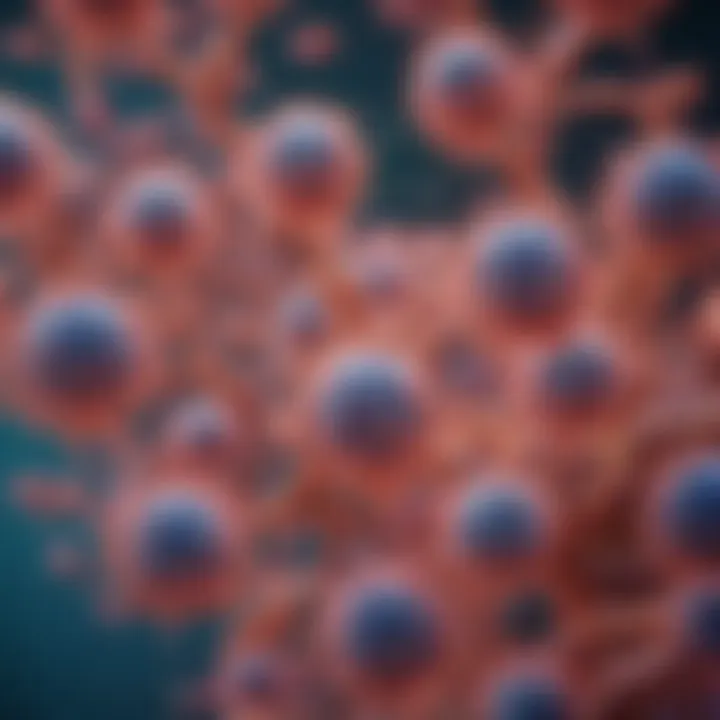
The maturation of dendritic cells is essential for their function. Upon encountering pathogens, they undergo a series of changes that enhance their antigen-presenting abilities and co-stimulatory activity. This maturation process allows dendritic cells not only to present antigens but also to provide contextual information about the nature of the pathogen, contributing to the differentiation of T cell subtypes, such as T or T.
The Importance of MHC Molecules
Major histocompatibility complex molecules are critical in the immune response because they present peptide fragments of proteins to T cells. MHC molecules are divided into two classes: MHC class I and MHC class II. MHC class I molecules present antigens to CD8 T cells, which are crucial for recognizing and eliminating infected or cancerous cells. On the other hand, MHC class II molecules are primarily engaged by CD4 T cells, facilitating help in coordinating the immune response.
The diversity of MHC molecules in a population is significant for understanding susceptibility to diseases and the effectiveness of vaccines. Variability in MHC genes contributes to the ability of individuals to respond to different pathogens. Consequently, studying MHC molecules can provide insights into personalized medicine and targeted immunotherapy.
T Cells in Immune Response
The function of T cells during immune responses is paramount for maintaining homeostasis and defending against pathogens. T cells, comprising mainly CD4 and CD8 subsets, engage in complex interactions that promote both immunity and tolerance. Understanding the role of T cells in immune responses lays groundwork for comprehending their involvement in various diseases and therapeutic approaches.
Primary Immune Response
The primary immune response occurs when the immune system encounters a novel pathogen for the first time. This is crucial for developing immunological memory. CD4 T cells, also known as helper T cells, are instrumental in signaling and orchestrating the immune response. Upon recognition of antigens presented by MHC class II molecules on antigen-presenting cells, CD4 T cells become activated, proliferating and differentiating into various subtypes, such as T and T cells. These subtypes facilitate B cell activation for antibody production and the recruitment of other immune cells, enhancing the overall response.
Furthermore, CD8 T cells, or cytotoxic T lymphocytes, mount an effective response against intracellular pathogens by directly killing infected cells. They recognize peptides presented by MHC class I molecules, which are found on nearly all nucleated cells. This direct contact leads to the death of infected cells, limiting pathogen replication.
The primary response can take days to develop fully, often involving clonal expansion of specific T cell populations. This time delay is why individuals may experience illness during initial infection, as the immune system ramps up its defenses.
Secondary Immune Response
The secondary immune response is described as the body’s enhanced reaction upon re-exposure to the same antigen. This response is characterized by a quicker and more robust activation of T and B cells, a phenomenon attributed to immunological memory. Memory T cells, which can be either CD4 or CD8 subsets, persist long after the initial response and can swiftly respond to subsequent infections by the same pathogen.
During the secondary response, memory CD4 T cells quickly differentiate into active helper T cells, resulting in a more effective coordination of the immune response. Memory CD8 T cells are likewise critical as they can rapidly proliferate and exert cytotoxic functions.
Overall, the protective nature of the secondary immune response underscores how T cells form the basis of adaptive immunity, providing longer-lasting protection against specific pathogens. This efficiency is leveraged in vaccinations, which aim to establish these memory T cells without causing disease.
"T cells are essential not just for fighting infections but also for providing long-lasting immunity that dictates the body's future responses to pathogens."
"T cells are essential not just for fighting infections but also for providing long-lasting immunity that dictates the body's future responses to pathogens."
The interaction of various T cell subsets during immune responses emphasizes the intricate dynamics and regulatory mechanisms needed for substantial immune defense. Importantly, understanding these responses is pivotal for developing new immunotherapies aimed at enhancing T cell functionality in disease states like cancer and autoimmune disorders.
Clinical Relevance of CD4 and CD8 T Cells
The clinical relevance of CD4 and CD8 T cells cannot be overstated in understanding immune system dynamics. These T cells play pivotal roles in the adaptive immune response and have significant implications for various diseases and therapeutic strategies. Their functionality impacts both normal health and conditions like autoimmune disorders and cancers.
T Cells and Autoimmunity
Autoimmune diseases arise when the immune system mistakenly attacks the body's own cells, often involving dysregulation of T cells. CD4 T cells, in particular, are known to be crucial in mediating the immune response against self-antigens. In conditions like rheumatoid arthritis and lupus, overactivated CD4 T cells contribute to tissue damage. Regulatory T cells, a subset of CD4 T cells, are vital for maintaining self-tolerance. Their dysfunction often leads to uninhibited autoimmune reactions. Understanding the role and balance of these T cells in autoimmunity is essential for developing targeted therapies that can restore normal immunological function and prevent tissue damage.
T Cells in Cancer Therapy
The utilization of CD4 and CD8 T cells in cancer therapy is an area of intensive research. Both have distinct roles in recognizing and eliminating tumor cells, which can enhance the effectiveness of cancer treatments.
Checkpoint Inhibitors
Checkpoint inhibitors are a form of immunotherapy that block specific proteins on immune cells, allowing T cells to function more effectively against tumors. These inhibitors, such as pembrolizumab and nivolumab, have revolutionized cancer treatment. They work primarily by removing inhibitory signals from T cells, thereby enhancing their cytotoxic function against cancer. A key characteristic of checkpoint inhibitors is their ability to promote durable responses in patients with certain types of cancer. This characteristic makes them highly sought after in clinical practice. However, they can also cause immune-related adverse events, complicating their use in some patients. Understanding both the advantages and risks associated with checkpoint inhibitors is critical for optimizing cancer treatment strategies.
CAR T Cell Therapy
Chimeric Antigen Receptor (CAR) T cell therapy represents another innovative approach in cancer treatment. This method involves engineering a patient’s T cells to express a receptor that targets specific cancer antigens. CAR T cell therapy has shown significant promise in treating hematologic malignancies such as acute lymphoblastic leukemia. The standout feature of CAR T cell therapy lies in its ability to produce powerful and specific immune responses against tumors. However, challenges remain, including potential severe side effects such as cytokine release syndrome. A careful assessment of these risks and benefits is necessary for clinicians considering this treatment for cancer patients.
The therapeutic potential of CD4 and CD8 T cells in both autoimmunity and cancer highlights their critical roles in human health. Understanding their mechanisms and interactions is paramount for advancing medical interventions.
The therapeutic potential of CD4 and CD8 T cells in both autoimmunity and cancer highlights their critical roles in human health. Understanding their mechanisms and interactions is paramount for advancing medical interventions.
The End and Future Directions
The exploration of CD3, CD4, and CD8 T cells underscores their significance in the field of immunology. Understanding these cells is paramount not only for academic research but also for clinical applications. In the conclusion, it is essential to revisit the remarkable roles these T cells play in adaptive immunity. Their functionality influences various health outcomes, including responses to pathogens and the effectiveness of vaccines.
Emerging Research Areas
The study of T cells is continually evolving. There are several emerging research areas that are worth highlighting:
- T Cell Exhaustion: This concept refers to the state where T cells lose their functionality after extended exposure to antigens, often seen in chronic infections and cancer. Understanding how to reverse exhaustion could enhance immune responses.
- T Cell Plasticity: The ability of T cells to adapt and change function based on microenvironment signals is an area of active inquiry. This plasticity could have implications for designing therapies that exploit T cell versatility.
- Personalized Immunotherapy: Tailoring immunotherapy approaches based on individual T cell profiles is an emerging field. This could lead to more effective cancer treatments and better management of autoimmune conditions.
- Microbiome Influence: Recent studies suggest the gut microbiome impacts T cell development and activity. Understanding this relationship may provide insights into various diseases and therapies.
Research in these areas holds promise for improving our understanding and manipulation of T cell behavior, enhancing therapeutic outcomes.
Potential for Therapeutic Innovations
The clinical implications of research on T cells are vast. Several therapeutic innovations are emerging:
- Checkpoint Inhibitors: These involve blocking proteins that inhibit T cell activity, allowing for enhanced immune responses against tumors. Drugs like Pembrolizumab and Nivolumab exemplify this approach, revolutionizing cancer therapy.
- CAR T Cell Therapy: Chimeric Antigen Receptor T cell therapy involves modifying a patient’s T cells to target specific cancers. This innovative treatment has shown remarkable success in certain hematological malignancies, demonstrating the potential of T cell engineering.
- Vaccination Strategies: Future vaccines may harness T cells more effectively to elicit stronger immune responses. This could lead to improved vaccines for diseases that currently have limited options.



